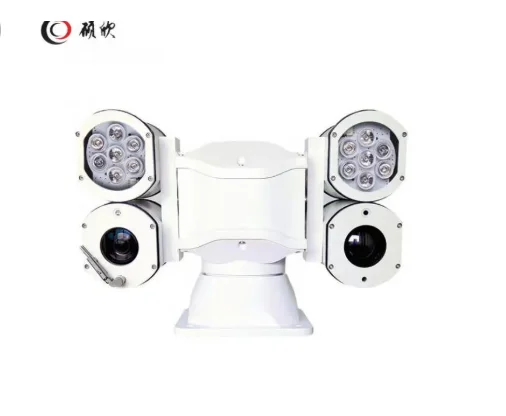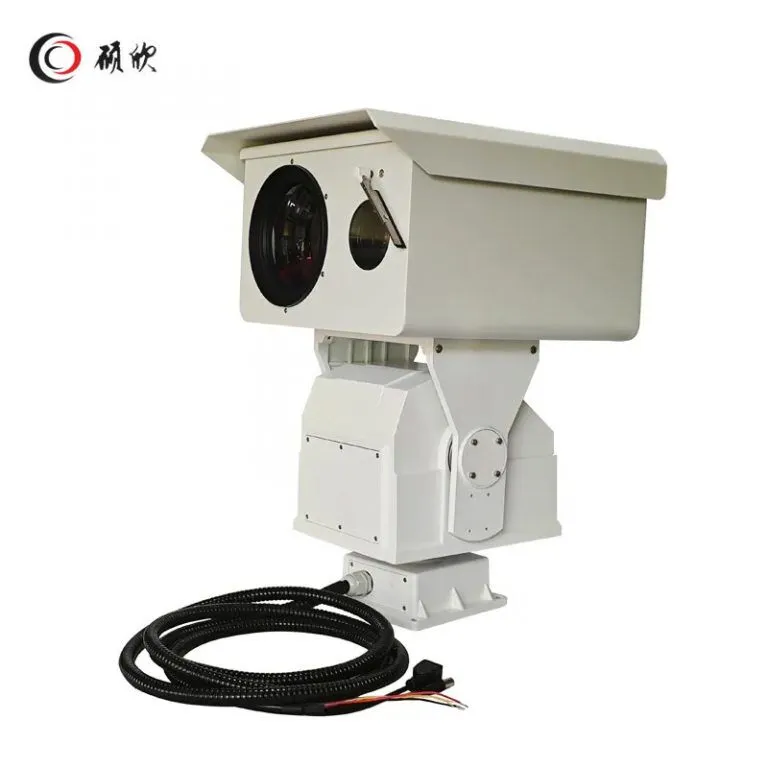توفر تكنولوجيا التصوير الحراري رؤية حاسمة في ظروف الضوء المنخفض وعدم الإضاءة عن طريق الكشف عن الإشعاع تحت الحمراء. ومع ذلك ، يمكن أن تتأثر دقتها بشكل كبير بالمتغيرات البيئية مثل الرطوبة ودرجات الحرارة المتطرفة والرياح وأضواء الشمس. هذه العوامل تشوه التوقيعات الحرارية وتقلل من وضوح الصورة ومدى الكشف عن التأثير. فهم هذه التحديات - وكيف تخففها الأنظمة المتقدمة - أمر أساسي للتصوير الحراري الموثوق به في المراقبة والبحث والإنقاذ والتطبيقات الصناعية. يدرس هذا الدليل التداخلات البيئية الرئيسية والحلول التكنولوجية التي تحافظ على الأداء في ظروف صعبة.
محتوى الرطوبة العالية في معرض الهواء مع إشارات الأشعة تحت الحمراء وصور الغموض
منتجات التصوير الحراري التقاط موجات الحرارة من الأجسام لإنشاء صور تظهر اختلافات درجات الحرارة. لكن الكثير من الرطوبة في الهواء يمكن أن تفسد الأمور. يمتص بخار الماء وتشتتت هذه الموجات الحرارية ، خاصة في نطاق الأشعة تحت الحمراء طويلة الموجة (LWIR) المستخدمة من قبل أجهزة الاستشعار مثل أجهزة الكشف غير المبردة لأكسيد الفاناديوم. لذلك ، غالباً ما تبدو الصور التي تم التقاطها في الأماكن الرطبة غامضة وأقل وضوحاً.
الرطوبة تعمل مثل الجدار. يضعف إشارات الحرارة من الأجسام وخلفياتها. هذا التشتت يضعف الخطوط بين درجات الحرارة المختلفة. هذا يجعل من الصعب تمييز الأشياء إذا كانت إشاراتها الحرارية متشابهة. بالنسبة للمهام مثل مراقبة المناطق أو العثور على الأشخاص في حالات الطوارئ ، يمكن أن يجعل هذا من الصعب تحديد الأشخاص أو الآلات الدافئة من بعيد.

لماذا اختيار كاميرا جيدة الضبط مهمة أكثر في الأماكن الرطبة
في الهواء الرطب، اختيار منتج التصوير الحراري المكيف بشكل جيد مهم جدا لنتائج واضحة. يساعد ضبط الكاميرا على التكيف مع أشياء مثل الرطوبة عن طريق إعادة تعيين كيفية قياس درجات الحرارة.
منتجات التصوير الحراري الجيدة ، مثل تلك من Shuoxin ، لديها حيل ضبط ذكية. إنها تتغير من تلقاء نفسها لتتناسب مع تغير الطقس ، مثل تغييرات الصباح أو المساء أو بعد المطر. الكاميرات بدون ضبط قوي يمكن أن تعطي نتائج عجيبة في هذه الظروف. هذا يقلل من فائدتها لمهامك.
كيف تؤثر درجة الحرارة المحيطة على نطاق الكشف والتباين الحراري؟
التحولات الباردة أو الحرارية الشديدة تغير درجات الحرارة الأساسية وتؤثر على اكتشاف الأجسام
تحدد درجة حرارة الهواء نقطة البداية للعثور على اختلافات الحرارة. في الأماكن الباردة جدا، الأشياء الدافئة مثل الناس تبرز بوضوح ضد الخلفية الباردة. وهذا يجعلها سهلة التعرف عليها. ولكن في الأماكن الساخنة ، حيث يكون الهواء دافئًا أو أكثر دفءًا مما تنظر إليه ، يتقلص الفرق الحراري.
هذا يمكن أن يسبب أخطاء. قد تفوت الأهداف التي تختلط مع الخلفية. أو قد تعتقد أن السطح الساخن ، الذي تدفئه الشمس ، شيء مهم. تعتمد موثوقية منتجات التصوير الحراري على مدى تعاملها مع هذه التأرجحات الحرارية.
الكاميرات ذات نطاقات درجات الحرارة الواسعة تعطي نتائج ثابتة
لمعالجة هذه القضايا، تتميز منتجات التصوير الحراري الراقية بنطاقات درجات حرارة واسعة وإعدادات حساسية ذكية. يمكنهم رؤية الأهداف بعيدًا مع صور واضحة. إنها تعمل بشكل جيد في جميع أنواع الأماكن ، من الأراضي الثلجية المتجمدة إلى الصحاري الحارقة ، دون الحاجة إلى تعديلها باليد.
الأنظمة مع كاشفات أكسيد الفاناديوم غير المبردة تلمع في درجات الحرارة المتغيرة. يتفاعلون بسرعة مع التغيرات الحرارية ويستخدمون القليل من الطاقة. على سبيل المثال، كاميرا التصوير الحراري نوع كاشف أكسيد الفاناديوم غير المبرد يحافظ على الأمور موثوقة بغض النظر عن الطقس.
كيف تتداخل الرياح مع استقرار التصوير الحراري؟
نقل الهواء يبرد الأشياء بشكل غير متساوي ويفسد أنماط الحرارة
تزيد الرياح من المشاكل عن طريق تغيير شعور الأشياء بالكاميرا. انها تنفخ على الأسطح وتأخذ الحرارة بسرعات مختلفة، اعتمادا على ما هو مصنوع من الكائن والطريقة التي تنفخ بها الرياح. هذا يجعل بقع التبريد غير المتساوية التي تفوض أنماط الحرارة التي تستخدمها الكاميرا لإصدار الصور.
على سبيل المثال، قد تجعل الرياح النباتات تبدو أكثر برودة من الأرض المحيطة بها، حتى لو كانت مصنوعة من نفس المواد. قد يبدو الناس في الأماكن الرياحية أكثر برودة على جانب واحد لأن الرياح تسرق المزيد من الحرارة هناك. هذا يمكن أن يخدع الكاميرا.
العدسات المستقرة والبرمجيات الذكية تصلح مشاكل الرياح
لمكافحة هذه القضايا، تستخدم منتجات التصوير الحراري الحديثة عدسات ثابتة وبرامج ذكية. هذه الأدوات تسلس التغييرات الغريبة الناجمة عن الرياح. ينظرون إلى العديد من إطارات الصور مع مرور الوقت للتعرف على مصادر الحرارة الحقيقية من العيوب الناجمة عن الرياح.
بعض البرامج الذكية تخمن كيف تتصرف المواد في الرياح، استنادا إلى العلوم حول الحرارة والهواء. هذا يجعل رصد الأشياء أكثر موثوقية، حتى عندما يكون هناك رياح في الخارج.
هل يمكن أن يشوه التعرض لأشعة الشمس قراءات الأشعة تحت الحمراء؟
ضوء الشمس يدفئ الأشياء بشكل غير متساوي ويخفي مصادر الحرارة الحقيقية
يمكن لضوء الشمس أن يفسد الصور تحت الحمراء عن طريق تسخين الأسطح بشكل غير متساوي. عندما تضيء الشمس، أشياء مثل الطرق أو المعدن تمتص طاقتها وتصبح ساخنة. يرسلون موجات حرارة تبدو مثل مصادر حرارة حقيقية إلى الكاميرا. يمكن أن يخفي هذا الأشياء الساخنة الفعلية ، مثل المحركات أو الأشخاص وراء الجدران المدفئة بالشمس.
كما يمكن للأسطح اللامع أن ترتد موجات الحرارة من ضوء الشمس إلى الكاميرا. هذا يخلق بقع مزيفة أو لمحات مشرقة تجعل الصور أقل وضوحا.
التكيف مع وقت اليوم يعزز التصوير الحراري في الهواء الطلق
للحصول على نتائج أفضل خلال النهار، يمكنك استخدام منتج التصوير الحراري الخاص بك في وقت مبكر من الصباح أو في وقت متأخر من المساء. هذه الأوقات لديها تداخل الشمس أقل. بعض الأنظمة الراقية ، مثل تلك من شوكسينيحتوي على أجهزة استشعار تقيس قوة ضوء الشمس وتعدل الكاميرا تلقائياً. هذا يبقي صورك دقيقة حتى عندما تغير الشمس الأشياء.
هل تؤثر المسافة على دقة الصورة ودقة الصورة؟
الأهداف البعيدة تصبح غامضة بسبب تدخل الهواء
كلما كان هدفك أبعد، أصعب منتجات التصوير الحراري للبقاء واضحا. يجب أن تسافر موجات الحرارة عبر المزيد من الهواء ، مما يمكن أن يفسدها. أشياء مثل الغبار أو قطرات الماء أو الدخان الدخاني تمتص وتشتت هذه الموجات. هذا يضعف الإشارة ويجعل الصور أقل وضوحا.
في المسافات الطويلة، نقاط الصورة أقل (بكسل) تغطي الهدف. هذا يقلل من التفاصيل التي يمكنك رؤيتها ، مما يجعل من الصعب تحديد الأشياء بوضوح.
العدسات طويلة المدى وميزات الطيف المزدوج تساعد في المشاهدة البعيدة
لإصلاح هذا ، تستخدم منتجات التصوير الحراري العليا عدسات خاصة طويلة المدى. هذه الحفاظ على الصور حادة حتى بعيدا عن طريق التركيز بقوة على المناطق الصغيرة. بعض، مثل أنظمة Shuoxinكما خلط كاميرات الضوء العادية مع أجهزة استشعار الحرارة. هذا يضيف تفاصيل إضافية لمساعدتك على التعرف على الأشياء بشكل أفضل، حتى من بعد.
هذه الميزات تجعل التصوير الحراري رائعًا لمهام مثل مراقبة الحدود أو تتبع الحياة البرية ، حيث لا يمكنك الاقتراب.

لماذا تعتبر المعايرة مهمة للحفاظ على الدقة عبر البيئات المتغيرة؟
أجهزة الاستشعار غير المنسقة تنجرف وتعطي نتائج خاطئة
مع مرور الوقت، يمكن أن تفقد أجهزة الاستشعار في منتجات التصوير الحراري الدقة. يحدث هذا لجميع الإلكترونيات، بما في ذلك كاشفات أكسيد الفاناديوم غير المبردة. أشياء مثل الاهتزازات، وتغيرات درجات الحرارة، أو الضوضاء الكهربائية تجعل هذا أسوأ. قد تظهر الكاميرا غير المصممة درجات الحرارة ببضع درجات. هذه مشكلة كبيرة بالنسبة للوظائف التي تحتاج إلى قياسات دقيقة، مثل فحص الأجهزة الكهربائية أو المسحات الطبية.
ميزات الضبط التلقائي تبقي القياسات صحيحة
للبقاء دقيقًا ، تستخدم منتجات التصوير الحراري ميزات الضبط التلقائي. هذه إعادة تعيين خطوط الكاميرا الأساسية باستخدام أدوات مدمجة ، مثل المصارع الصغيرة التي تمنع الحرارة الخارجية للحظة. هذا يحدث تلقائيا، لذلك لا تحتاج إلى إصلاحه بنفسك.
هذه الأنظمة الذكية تبقي القياسات ثابتة، حتى في الظروف المتغيرة. إنها ضرورية للمحترفين الذين يحتاجون إلى نتائج موثوقة في الأماكن الصعبة.
الأسئلة الشائعة
Q1: ما مدى دقة منتج التصوير الحراري النموذجي؟
ج: معظمها دقيقة في حدود ± 2 درجة مئوية أو ± 2٪ عند ضبط الحق واستخدامها في ظروف جيدة.
س2: هل يمكن للضباب أن يفسد الصور الحرارية الخاصة بي؟
ج: نعم، قطرات المياه الصغيرة في الضباب تنتشر موجات الحرارة، مما يجعل الصور غامضة، وخاصة بعيدة.
Q3: ما هو مستشعر جيد للاستخدام اليومي؟
ج: كاميرا التصوير الحراري نوع مستشعر كاشف أكسيد الفاناديوم غير المبرد يعمل بشكل جيد. يوازن التكلفة والحساسية وسهولة الصيانة.

